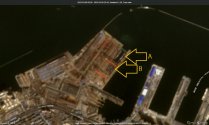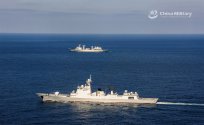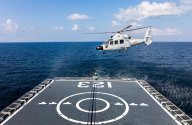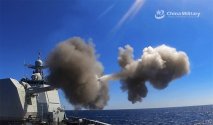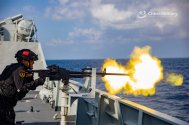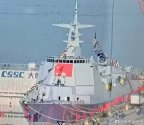You are using an out of date browser. It may not display this or other websites correctly.
You should upgrade or use an alternative browser.
You should upgrade or use an alternative browser.
052C/052D Class Destroyers
- Thread starter Jeff Head
- Start date
Just step through the intercept sequence. Whatever that target was, it clearly disappeared before the missile’s warhead detonated. The place of detonation was quite a bit further away from the last frame of the target.It looks like a successful intercept to me, we observe the splash.
That guy's tweet was already posted elsewhere, I'm not sure why it needs to be posted here as well when the take is hardly a good one or a logical one. I really don't see why he believes it was not a successful intercept from the video footage.
I don’t see why make a big deal out of a miss. It happens from time to time to any SAM.
What I am not convinced of is that indeed is an HHQ-9 intercept.
Just step through the intercept sequence. Whatever that target was, it clearly disappeared before the missile’s warhead detonated. The place of detonation was quite a bit further away from the last frame of the target.
I don’t see why make a big deal out of a miss. It happens from time to time to any SAM.
What I am not convinced of is that indeed is an HHQ-9 intercept.
What makes you think that there is only one target missile?
lcloo
Major
I won't call it a miss. The target was already dived into the sea before the missile reach the intercept point. At this point of time, the interceptor would have lose the target since it was no more in the air.
If the target continue to fly forward instead of diving into the sea, it would set off the proximity fuse of the missile when their distance close.
A SAM cannot hit an aircraft if that aircraft is already under water.
The 4 frames below happened within 16th seconds of the video.
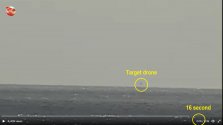
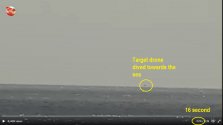
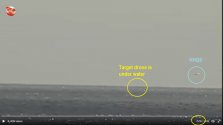
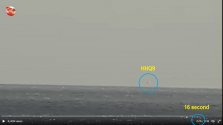
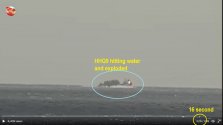
If the target continue to fly forward instead of diving into the sea, it would set off the proximity fuse of the missile when their distance close.
A SAM cannot hit an aircraft if that aircraft is already under water.
The 4 frames below happened within 16th seconds of the video.





Last edited:
Just step through the intercept sequence. Whatever that target was, it clearly disappeared before the missile’s warhead detonated. The place of detonation was quite a bit further away from the last frame of the target.
I don’t see why make a big deal out of a miss. It happens from time to time to any SAM.
What I am not convinced of is that indeed is an HHQ-9 intercept.
I won't call it a miss. The target was already dived into the sea before the missile reach the intercept point. At this point of time, the interceptor would have lose the target since it was no more in the air.
If the target continue to fly forward instead of diving into the sea, it would set off the proximity fuse of the missile when their distance close.
A SAM cannot hit an aircraft if that aircraft is already under water.
The 4 frames below happened within 16th seconds of the video.
View attachment 108649View attachment 108650View attachment 108651View attachment 108652View attachment 108653
I think the HQ-9 and the target drone should be reversed.
I.e.: the yellow circle is the HQ-9 and the blue circle is the target drone.
Sea skimming drones and missiles have a relatively flat trajectory (like what the blue circle is), while area air defense naval SAMs targeting sea skimming targets generally have a "diving" trajectory".
HQ-9 has a large fragmentation warhead.
This video looks to me like a sea skimming target drone destroyed by the fragmentation effect of the HQ-9, the blue circle being part of the HQ-9 immediately post fragmentation.
What do we know about the HHQ-9 fuze?My thoughts exactly. What would set off the fuse if the seeker didn't detect the target in close proximity? If it were a failed intercept then the interceptor would surely enter the water without exploding.
If the water surface falls within the range cut off region, then it can conceivably trigger the fuze which results in the warhead detonation. Most SAMs have a minimum engagement altitude, and this is usually a function of the fuze design.
too mentioned about this on Twitter. Both 052DLs pointed by arrow A are already floating in the dry dock.The launching of 2 (out of 5) 052DLs currently under construction in Dalian is imminent. Posted by @单手搓核弹 on Weibo.
View attachment 108744
